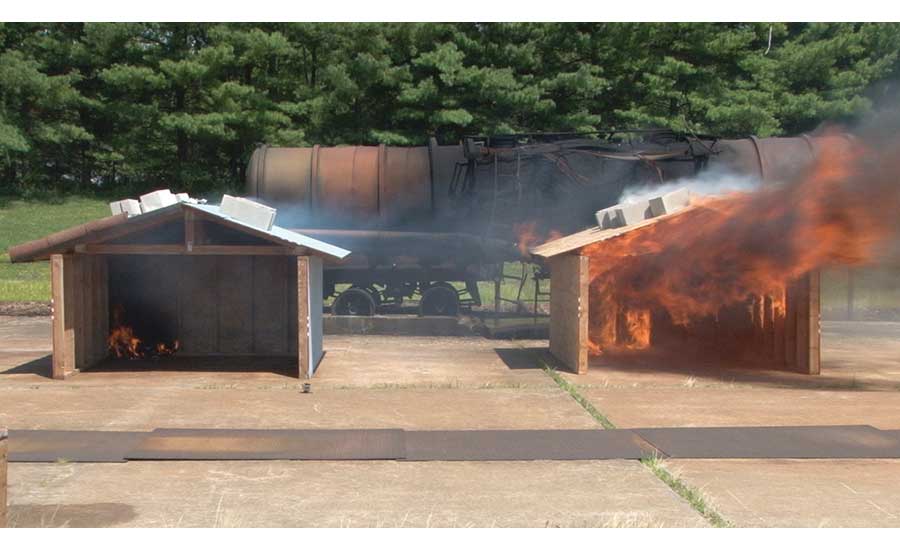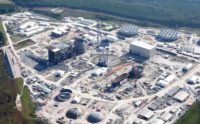In the early morning hours of April 24, flames ripped through a 180-unit wood-framed apartment complex under construction in Concord, Calif. Fortunately, the site was unoccupied at the time of the fire, which firefighters brought under control by dawn. But the damage was done; the $55-million project was declared a total loss.
Though investigators have yet to determine how the blaze started, the scenario was disturbingly familiar to Michael Feigin, chief construction officer and executive vice president of Arlington, Va.-based developer AvalonBay Communities Inc. Just last year, fire devastated a four-story, 235-unit complex his firm was building in Maplewood, N.J. Despite augmenting industry-standard fire prevention steps by adding a full sprinkler system, the fire still occurred. No cause was ever determined.
AvalonBay had established a good approach to fire prevention, Feigin insists. It just wasn’t good enough. “We wanted a strategy that would eliminate the risk of construction fires altogether,” he says.
That might sound like a tall order, given the widespread use of wood in multifamily construction. According to the American Wood Council (AWC), more than 60% of U.S. apartment buildings built between 2006 and 2015 used wood framing, with lower costs often given for its selection over steel or concrete. In most jurisdictions, fire-retardant treated (FRT) wood is required only on exterior walls, with more combustible materials primarily used for interiors.
Yet while the National Fire Protection Association’s standards require owners to create construction-phase fire safety programs, incidents continue to happen. NFPA’s most recent research suggests that U.S. fire departments respond to an average of 830 fires in multifamily projects under construction each year. AWC has stepped up efforts to educate contractors on fire safety, creating a variety of training materials and guidance manuals.
Feigin believes AvalonBay’s recently implemented fire-elimination strategy takes many current fire-safety practices a step further. For example, moving all welding, brazing and other hot-work activities off-site eliminates common ignition sources, while beefed-up perimeter fencing and high-definition cameras enhance existing site security.
But to enhance the effectiveness of fire-watch patrols, an industry-accepted safety practice of regular site inspections, Feigin says he worried that the cost of just adding more people might not justify the results. Humans are fallible, he reasoned, and a fire could quickly erupt in an area within minutes after being inspected.
“We wanted to take human error out of the equation,” he says.
Sensors and Defenders
AvalonBay found a technology solution that could provide both high reliability and support for its nationwide project portfolio. The company turned to Pillar Technologies, a New York City-based firm that has developed sensor-based risk management strategies for construction sites.
A spin-off of Boston’s Wentworth Institute of Technology, Pillar Technologies works with contractors to deploy on-site sensor networks that constantly monitor environmental conditions on a jobsite. Likening the approach to the human nervous system, Pillar CEO Alex Schwarzkopf explains that the sensors watch for any real-time deviations from a site’s “resting heartbeat.”
“Detection of any unusual change—a temperature spike from a fire outbreak, for example—automatically generates a text alert to designated project managers,” Schwarzkopf says.
Each sensor covers an area up to 3,000 sq ft. A variety of mounting options allow the sensors to be relocated by contractor personnel as work progresses. Rugged casings help sensors withstand the often rough construction environments. Redundant network gateways and low-power, wide-area networks also safeguard the remotely monitored system’s coverage and reliability.
“If one gateway fails, the other immediately picks up and notifies us that service is required.”
– Alex Schwarzkopf, CEO, Pillar
“If one gateway fails, the other immediately picks up and notifies us that service is required,” Schwarzkopf says.
AvalonBay’s projects are also utilizing another form of fire-prevention technology. Mighty Fire Breaker, a specially formulated treatment developed by M-Fire Suppression Inc., Torrance, Calif. The treatment can be applied easily to non-FRT wood, which typically makes up about 90% of the framing on a multifamily structure.
M-Fire founder and chairman Steve Conboy, a 40-year construction industry veteran, says the spray addresses an overlooked “fourth element” of the traditional fire triangle—chemical reaction.
“Fires won’t accelerate until the contractor starts to install wall and floor sheeting,” he explains. “Once a fire ignites, that environment creates gases that cause a flashover, resulting in a larger fire.”
By applying M-Fire to non-FRT wood, “we defend 100% of the lumber with chemistry that removes the energy of a fire from being so disruptive to not only the building but also the surrounding community,” Conboy says.
M-Fire controls the application chain, working with builders to schedule the application by its certified staff so that the wood is ready when construction begins. Accepted for use nationwide, M-Fire is being used at multifamily projects on both coasts, including eight AvalonBay projects scheduled to get underway this year.
Conboy says M-Fire costs nearly one-quarter what it does to build entirely with FRT lumber, and could ultimately lead to lower insurance premiums for builders. Yet he insists the product is not intended to compete with or replace established industry standards. Rather, he says, “we’re defending what nobody has defended before.”
Systematic Protection
Other builders have stepped up efforts to minimize the risk of construction site fires where wood is the predominant building material.
For the past four years, Houston-based Hanover Co. has accelerated the activation of fire sprinkler systems before framing is complete and before drywall installation begins.
“During the initial stages of design, we design sprinkler systems so they can be activated in a multi-phased manner,” explains Howard Dyer-Smith, Hanover’s president of construction.
“We’re defending what nobody has defended before.”
– Steve Conboy, Founder and Chairman, M-Fire
“In cold climates, this requires the use of temporary ‘dry systems’ that are not subject to freezing. While these temporary systems do not provide full building protection, we think they would be effective against most construction fires,” he says.
Dyer-Smith admits that the solution is not perfect, and that “a lot of legwork” is needed to get sprinkler subcontractors on board with the approach. Because active sprinkler heads are vulnerable to inadvertent impacts during construction, leak detection and prompt response plans are essential to mitigate potential water damage.
“From a management standpoint, it is not easy to coordinate everything that needs to happen,” he says, “but we still think it is well worth the effort to reduce the risk.”
Jim Driggs, managing director, quality assurance, for Trammell Crow Residential, Austin, Texas, says his firm emphasizes awareness and education across the project team, with GCs and subs contractually required to follow the same procedures, including a strict no-smoking policy and full compliance with hot-work protocols.
Each project also has its own fire plan, which includes an introductory on-site meeting with local fire department officials.
“Many times, fire departments don’t know where the project is,” Driggs says. “By visiting the site, they can see what’s going up and know what to expect if something does happen.”





Post a comment to this article
Report Abusive Comment